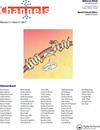一个保守的精氨酸/赖氨酸基序促进KCNE1和KCNE2的内质网输出以调节KCNQ1通道活性
IF 3.2
3区 生物学
Q2 BIOCHEMISTRY & MOLECULAR BIOLOGY
引用次数: 4
摘要
KCNE β-亚基在调节心脏电压门控钾通道中起关键作用。其中,KCNE1与KCNQ1通道相关联,赋予慢激活的IKs电流,而KCNE2作为主要负调制器抑制KCNQ1的电流幅度。这些通道的任何异常都会导致严重的心肌疾病,如长QT综合征(LQTS)。据报道,KCNE1的转运缺陷解释了LQT5的发病机制。然而,KCNE向前贩运的分子机制仍然难以捉摸。在这里,我们描述了一个基于精氨酸/赖氨酸的基序([R/K](S)[R/K][R/K])在HEK293细胞近端c端调节内质网(ER)输出KCNE1和KCNE2。值得注意的是,这个基序在KCNE家族中是高度保守的。我们的研究结果表明,由基序(KSKR)控制的KCNE2的正向转运对于抑制KCNQ1的细胞表面表达和电流幅度是必不可少的。与KCNE2不同,KCNE1中的基序(RSKK)除了介导KCNE1的内质网输出外,还在KCNQ1的门控调节中起重要作用。此外,c末端的截断并没有降低KCNE2对KCNQ1的表观亲和力,这表明KCNE2的刚性c末端可能不会与KCNQ1发生物理相互作用。相反,KCNE1的c端对其与KCNQ1的相互作用至关重要。这些结果有助于理解KCNE1和KCNE2膜靶向的机制,以及它们如何与KCNQ1一起调节通道活性。本文章由计算机程序翻译,如有差异,请以英文原文为准。
A conserved arginine/lysine-based motif promotes ER export of KCNE1 and KCNE2 to regulate KCNQ1 channel activity
ABSTRACT KCNE β-subunits play critical roles in modulating cardiac voltage-gated potassium channels. Among them, KCNE1 associates with KCNQ1 channel to confer a slow-activated IKs current, while KCNE2 functions as a dominant negative modulator to suppress the current amplitude of KCNQ1. Any anomaly in these channels will lead to serious myocardial diseases, such as the long QT syndrome (LQTS). Trafficking defects of KCNE1 have been reported to account for the pathogenesis of LQT5. However, the molecular mechanisms underlying KCNE forward trafficking remain elusive. Here, we describe an arginine/lysine-based motif ([R/K](S)[R/K][R/K]) in the proximal C-terminus regulating the endoplasmic reticulum (ER) export of KCNE1 and KCNE2 in HEK293 cells. Notably, this motif is highly conserved in the KCNE family. Our results indicate that the forward trafficking of KCNE2 controlled by the motif (KSKR) is essential for suppressing the cell surface expression and current amplitude of KCNQ1. Unlike KCNE2, the motif (RSKK) in KCNE1 plays important roles in modulating the gating of KCNQ1 in addition to mediating the ER export of KCNE1. Furthermore, truncations of the C-terminus did not reduce the apparent affinity of KCNE2 for KCNQ1, demonstrating that the rigid C-terminus of KCNE2 may not physically interact with KCNQ1. In contrast, the KCNE1 C-terminus is critical for its interaction with KCNQ1. These results contribute to the understanding of the mechanisms of KCNE1 and KCNE2 membrane targeting and how they coassemble with KCNQ1 to regulate the channels activity.
求助全文
通过发布文献求助,成功后即可免费获取论文全文。
去求助
来源期刊

Channels
生物-生化与分子生物学
CiteScore
5.90
自引率
0.00%
发文量
21
审稿时长
6-12 weeks
期刊介绍:
Channels is an open access journal for all aspects of ion channel research. The journal publishes high quality papers that shed new light on ion channel and ion transporter/exchanger function, structure, biophysics, pharmacology, and regulation in health and disease.
Channels welcomes interdisciplinary approaches that address ion channel physiology in areas such as neuroscience, cardiovascular sciences, cancer research, endocrinology, and gastroenterology. Our aim is to foster communication among the ion channel and transporter communities and facilitate the advancement of the field.
 求助内容:
求助内容: 应助结果提醒方式:
应助结果提醒方式:


